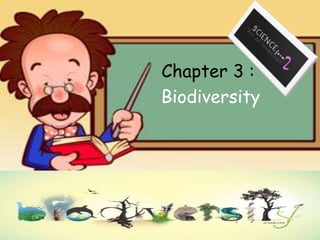
Chapter 3 biodiversity
- 2. 1. What is biodiversity? Biodiversity is also know as biological diversity Biodiversity refers to wide variety of organisms on earth
- 3. Observe the biodiversity in this rainforest
- 4. Where can we find biodiversity?
- 5. 2. BIODIVERSITY ANIMALS PLANTS
- 6. 1. There are two main groups of animals: Animals Vertebrates Invertebrates Animal with backbones Animal without backbones
- 7. A. Invertebrates a. More than 90% of animals are invertebrates b. Since invertebrates have no backbone, they are usually small in size. c. Examples: Inserts such as ants, butterflies, flies, and cockroaches Spiders Crabs Prawns Worms Mollusks such as snails
- 8. B. Vertebrates a. Smaller group compared to invertebrates. However, we are more familiar with this group of animals b. Since vertebrates have backbone to support their weight, many vertebrates are large in size c. Examples: Elephants Eagles Whales Snakes Frogs Clown fish
- 9. Classification of vertebrates Vertebrates Amphibians Birds Reptiles Fish Mammals
- 10. Sword Fish Lampam Banded Leaf Fish
- 11. 1.Common characteristics of fish • Body covered with slimy scales for protection • Have fins and tail to swim • Streamlined bodies to swim well • Breathe through gills •Cold-blooded (body temperature changes with the surrounding temperature) • Lay eggs •Carry out external fertilization (eggs are fertilized outside the female body)
- 12. Toad Salamander
- 13. 1. Common characteristics of amphibians • Body covered with moist skin •Adults can live on land and water • Adults breathe with lung on land and through moist skin when in water • Cold-blooded (body temperature changes with the surrounding temperature) • Lay eggs covered with jelly-like substance • Young amphibians live in water and breathe through gills • Carry out external fertilization (eggs are fertilized outside the female body)
- 14. Tortoises Snake Crocodile
- 15. 1. Common characteristics of reptiles • Body covered with hard and dry scales for protection • Breathe with lungs • Cold-blooded (body temperature changes with surrounding temperature) • Lay eggs with leathery shells • Carry out internal fertilization (eggs are fertilized inside the female body)
- 17. 1.Common characteristics of birds • Body covered with feathers • Have wings and beak • Breathe with lungs • Warm-blooded (body temperature remains constant) • Lay eggs with hard shells • Carry out internal fertilization (eggs are fertilized inside the female body)
- 18. Camel Orangutan Tiger Rhinoceros Elephant
- 19. 1. Common characteristics of mammals • Body covered with hair or fur • Breathe with lungs • Warm-blooded (body temperature remains constant) • Give birth to live young • Carry out internal fertilization (eggs are fertilized inside the female body) • Young mammals feed on milk from their mother’s mammary glands
- 20. Plants Flowering Plants Non-flowering Plants Examples Examples
- 21. Plants Produce flowers Do not produce flowers Single blade Leaves divided leaves Into leaflets Needle-like Leaves divided leaves into leaflets Leave with Leaves with parallel veinsnetwork-like veins Leaves with Leaves with parallel veins network-like veins
- 22. Non-flowering plants • Further divided to conifers, ferns, mosses, and algae • Conifers Reproduce by seeds produced in cones Have needle-like leaves Example: casuarinas, pine • Ferns Reproduced by spores on the underside of leaves Example: Bird’s nest fern, stag’s horn fern
- 23. • Mosses Reproduce by spores produced in capsules Example: White moss •Algae Very simple plants No proper roots, stems, leaves Example: Seaweed
- 24. Flowering plants • Produce flower for reproduction • Flower fruits and seeds new plants • Based on the seeds they produce, flowering plants can be further divided into 2 groups Flowering plants Monocotyledons Dicotyledons Have seeds with one cotyledon Have seeds with two cotyledon
- 25. • Each seed has only one cotyledon One cotyledon Amaize grain cut into half
- 26. • Their leaves have parallel veins Parallel veins Maize Fibrous roots • They have fibrous roots
- 27. • Mostly are herbaceous plant (plants with non-woody stems) • Examples: Grasses, sugar cane, banana, paddy, and orchid plants
- 28. • Each seed has two cotyledons Two cotyledons Agreen bean (split into two)
- 29. • Their leaves have network-like veins Network-like Balsam plant veins Tap root • They have fibrous tap roots
- 30. • They may be trees, shrubs or herbaceous • Examples: Rubber and durian trees, hibiscus, morning glory and sunflower plants
